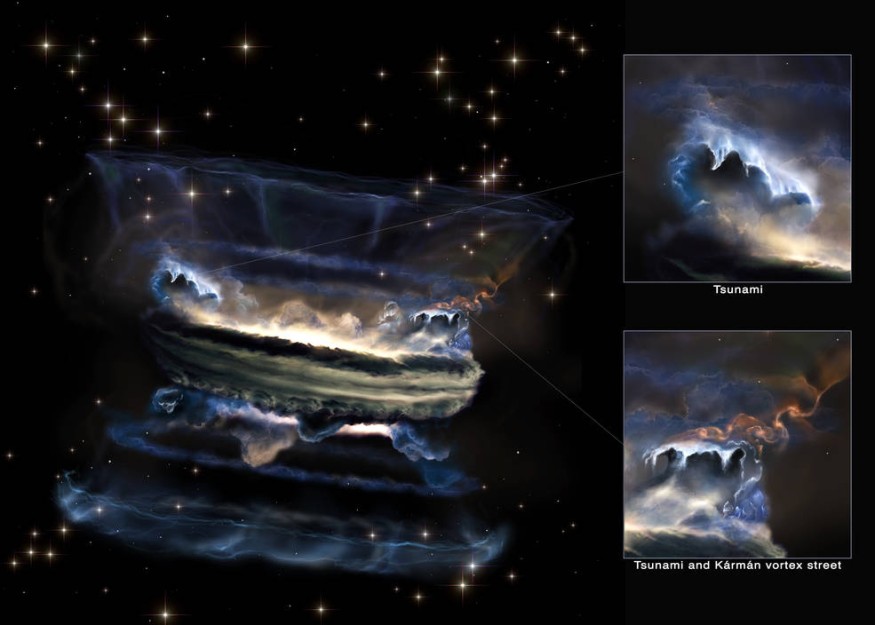Gas escaping from the gravitational attraction of a supermassive black hole can cause tsunami-like patterns in the depths of space.
According to new computer simulations, the mysterious atmosphere surrounding supermassive black holes may house the universe's greatest tsunami-like structures. The Astrophysical Journal published the NASA-funded study titled "Multiphase Agn Winds From X-Ray-Irradiated Disk Atmospheres."
"What governs the phenomena here on Earth are the laws of physics that can explain things in outer space and even far away from the black hole," Daniel Proga, an astrophysicist at the University of Las Vegas, Nevada, said in a statement released by NASA.

Understanding Blackholes
Black holes are enigmatic themselves. But understanding the mathematical equations that describe how black holes deform their surroundings even tens of light-years away is a more challenging issue for theoretical astrophysicists.
The "active galactic nucleus" is a situation in which a black hole with a mass higher than a million suns feeds on material from a surrounding disk at the galaxy's center. Relativistic jets can be found at the poles of active galactic nuclei, as well as a thick coating of material that obscures our view of center activity. However, the plasma that flows above the disk, far enough away from the black hole to avoid falling into it, glows brilliantly in X-rays, so brightly that astronomers have been able to catalog over a million of these objects.
In what is known as an "outflow," NASA said strong winds rush out of this central region in part propelled by this radiation. Researchers aim to learn more about how gas interacts with X-rays generally, not just around the event horizon, where the X-rays are generated. Up to tens of light-years away from the black hole, the consequences of these center X-rays can be significant. X-ray irradiation can explain the presence of diverse populations of denser regions called clouds in addition to launching outflows. Proga and his colleagues conducted simulations last year that showed that an outflow could produce more distant clouds.
Tim Waters, a postdoctoral researcher at UNLV who is also a visiting scientist at Los Alamos National Laboratory, also said in the same NASA statement that these clouds are ten times as hot as the Sun's surface and move simultaneously solar wind.
ALSO READ : Black Holes, Neutron Stars Merge: Astrophysicists' 'First-Ever' Confirmed Merger Detection
Black Holes May Generate Tsunami-Like Structures
For the first time, the team has demonstrated how complex the clouds are within these discharges from the primary black hole engine. Their simulations indicate that the relatively chilly atmosphere of the spinning disk can generate ripples akin to the ocean's surface, just within the distance where the supermassive black hole loses control over the surrounding matter.
These waves can steep up into spiraling vortex structures that can reach a height of 10 light-years above the disk when they interact with hot winds. That is more than twice as far as the Sun is from its nearest star, just over 4 light-years away. When tsunami clouds form, they are no longer affected by the gravity of the black hole.
The simulations reveal how X-ray light from near-black hole plasma inflates hot gas pockets within the accretion disk's atmosphere beyond a certain distance from the active galactic center. The heated plasma expands and disrupts the surrounding cooler gas as it rises like a balloon. No matter what unit of measurement is employed, it can be extremely hot, ranging from hundreds of thousands to tens of millions of degrees.
According to TechExplorist, These heated gas pockets on the accretion disk's outskirts start the outward-spreading disturbance rather than an underwater volcanic eruption triggering tsunamis.
The vortexed streets of Kármán may appear strange and far away. Still, they are frequent weather phenomena on Earth that structural engineers must be concerned about.
The new findings challenge a long-held belief that clouds grow spontaneously from hot gas in the region of an active galactic nucleus due to fluid instability. They also refute the notion that magnetic fields are required to drive colder gas from a disk into the air.
RELATED ARTICLE : Tennis Ball Scale Primordial Black Holes: Will be Detected by a New Device Which Captures Gravitational Wave, Developed by Astrophysicists
Check out more news and information on Space on Science Times.











